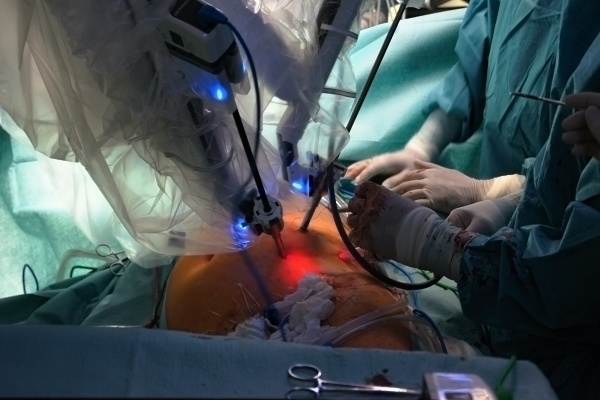, category News
Na Homolce Hospital – A World Leader: Vascular Surgeons Will Perform Their 400th Robotic Surgery
The Na Homolce Hospital is a world leader in the number of robot-assisted vascular procedures carried out in the field of vascular surgery.
Today, Senior Consultant Dr. Štádler and his team will perform their 400th robot-assisted procedure already. On Jiřina, a fifty-nine year old patient from the city of Most who suffers from leg pain as a result of the stenosis of the aorta and the iliac arteries, they will perform a bypass of these major abdominal blood vessels in a minimally invasive method with the use of the Da Vinci Xi robotic system.
“A vascular prosthesis will be used to bypass the affected arteries. In this particular case, the so-called Y prosthesis will be used, i.e. a prosthesis, whose one end is connected to the aorta and the other end has two branches which will replace both of the affected iliac arteries to provide blood supply to both legs,” says Professor MUDr. Petr Štádler, Ph.D., Senior Consultant of the Vascular Surgery Department. Unlike in other hospitals, we will perform the surgery in a minimally invasive method, using a robot,” he adds.
The narrowing of the abdominal aorta and of the iliac arteries or, as the case may be, their occlusion develops as a result of atherosclerosis. Most often, it is caused by an unhealthy lifestyle and, in particular, by smoking. “Patients with this condition suffer from what is known as the claudication pain of the legs. It is a muscular pain that occurs mainly when walking, due to an inadequate blood supply to the muscles, hence their insufficient oxygenation,” explains Štádler.
The Na Homolce Hospital is a world pioneer in robotic vascular surgery
In the world, there are only a few departments that practise robot-assisted vascular procedures, e.g. in the USA, France, Great Britain, the Netherlands and South Korea. Most likely, the low number of these departments is caused by the lack of previous experience of vascular surgeons with laparoscopy. Laparoscopy and robotics rank among “minimally invasive” procedures that make it possible to perform identical procedures as in open surgery but through minimum incisions. For the patient, this option offers a major advantage. After a minimally invasive procedure, he/she recovers and resumes normal life very fast while, after the classical surgery, he/she is at a nonnegligible risk of, inter alia, developing incisional hernia, often requiring another surgery. Of course, the patients also highly appreciate the excellent cosmetic effect.
The Na Homolce Hospital is one of the few sites that had firsthand experience with laparoscopic arterial surgery before the advent of robotic technology. As a result, after the purchase of the robotic equipment in 2005, it could easily switch to robotic surgery and gained an edge on other facilities. “The transition from laparoscopy to robotic surgery permitted a fast performance of anastomosis, i.e. a vascular connection which is performed on the artery while the blood flow between the applied vessel clamps is interrupted. The time of the application of the vessel clamp which, in the case of laparoscopy, was extremely long, is reduced to a time comparable with open vascular surgeries, but the advantage of laparoscopy, i.e. minimally invasive nature of the procedure, is retained,” says Štádler.
There is no other department in the Czech Republic where robot-assisted vascular procedures are performed
In the Czech Republic, the Na Homolce Hospital is the only hospital where robot-assisted vascular procedures are performed. Most often, procedures on the aorta in its abdominal section and on iliac arteries are performed. The reason for this is a pathological enlargement of a certain portion of the artery, i.e. aneurysm, or, on the contrary, atherosclerotic stenosis due to the sclerosis of the vascular wall. In addition to this, procedures on the splenic or pelvic arteries, on renal arteries or on the arteries providing blood supply to abdominal organs account for a relatively small portion of the robotic vascular interventions. “In general, at the Na Homolce Hospital, all available methods of treatment are used. For each patient, we always choose the most appropriate method according to the type and extent of artery impairment. This means that some arterial conditions are treated by balloon angioplasty, others by classical surgery and yet others laparoscopically or robotically,“ says Štádler. “Any patient from the Czech Republic may undergo robotic vascular surgery at the Na Homolce Hospital, if such a procedure is indicated for the patient, i.e. he/she must first get an appointment for an examination in our hospital,” he adds.
The robotic vascular surgery programme at the Na Homolce Hospital has earned considerable attention of experts and an extraordinary international prestige. As a result, the Na Homolce Hospital was ranked among the leading departments in the world in the field under review and it serves as an international training centre. Senior Consultant Dr. Štádler took an active part in the performance of the first robotic vascular surgery in Memphis, USA, he carried out the first robotic vascular procedures in India or South Korea and, together with his colleagues, also in Poland and Russia. For the development of robotic surgery, he received a number of international awards.
How does the Da Vinci Xi robot work?
The tower contains four movable arms which hold surgical instruments and a small camera. The tips of the arms with instruments are inserted into the body of the patient and the surgeon performs the surgery by remote control of these arms. The arms move in all directions and allow a 360-degree movement of the instrument.
The second part of the robot is formed by the console to control the robot. The surgeon sits at the console, looks into a viewer where he can see a 3D image telecasted from a camera inside the body of the patient and controls the robotic arm by a joystick. The robotic system completely eliminates tremors and enhances the movement of the surgeon.
The third and fourth parts of the robotic system consist in the tower with surgical instrument and the operating room table. The tower contains the necessary instruments and a computer system. The table is fully synchronised with the entire system, so even when a surgical instrument is inserted into the body of a patient, it can be moved.



